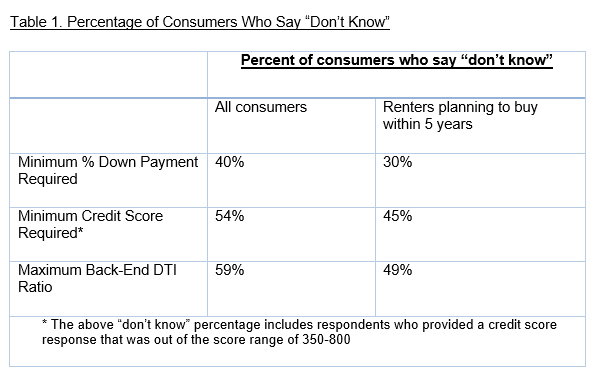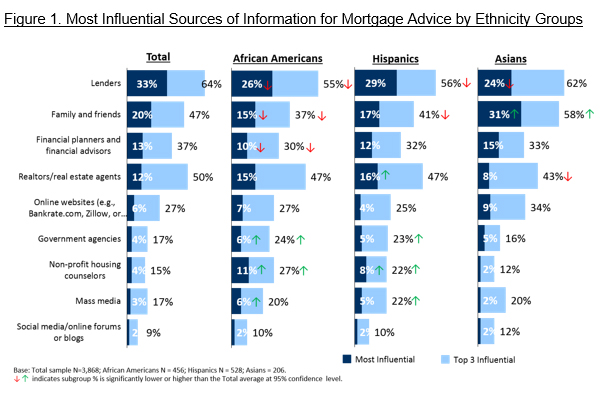Survey Reveals Significant Gaps in Consumer Knowledge of the Requirements to Qualify for a Mortgage

Despite easing credit standards,1 improving labor markets, and consumers’ continued strong aspiration to own, the homeownership rate remains at a low level.2 This situation has prompted policymakers, regulators, and industry participants to examine the challenges facing consumers when trying to get a mortgage. In prior surveys, renters have told us that saving for a down payment and their credit score are the leading obstacles to obtaining a mortgage.3 To the extent that consumers may have misunderstandings about the requirements for qualifying for a mortgage, there may be an opportunity to expand access responsibly by addressing such misperceptions.
This past summer, Fannie Mae’s Economic & Strategic Research Group conducted a nationwide, online survey4 of 3,868 consumers to measure their knowledge of the mortgage qualification process.5 Key survey findings include:
• There is a significant lack of understanding about minimum mortgage qualification criteria not only among consumers in general but, more importantly, among renters who plan to purchase a home within the next five years.
• Lenders are cited by consumers as the most influential source of mortgage advice, suggesting the value of working closely with lenders to improve consumers’ knowledge of qualification criteria.
As shown in Table 1, when asked about key mortgage qualification criteria (such as down payment percentage, borrower’s credit score, and debt-to-income ratio), approximately half of consumers selected “don’t know” or failed to provide a valid answer (e.g., a credit score that falls within the range of possible credit scores). The knowledge gap was nearly as great for renters who plan to purchase within five years.

Furthermore, as shown in Table 2, for respondents who were able to provide an answer, the mean responses regarding minimum down payment (12 percent) was four times the actual requirement.6 The mean response for minimum credit score was above Fannie Mae’s requirements6 but was far closer to actual minimum credit score requirements than the response for minimum down payment. While only five percent of respondents provided an answer between 40 and 50 percent, the mean response regarding maximum acceptable back-end debt-to-income (DTI) ratio (44 percent) was very close to the actual requirement (generally 45 percent) with a wide variation in the responses around the mean.6 The same pattern of responses held for renters who plan to buy within five years.

Prior Fannie Mae surveys have shown that the aspiration to own a home remains strong and that consumers perceive the down payment and their credit score as leading obstacles to obtaining a mortgage. Advancing from aspiration to sustainable homeownership is more likely to occur if consumers have an accurate understanding of the requirements to qualify for a mortgage. While it can take years to improve one’s credit score or save for a down payment, undertaking such efforts based on inaccurate information may lead to a needless delay in reaching the goal of owning a home.
Another important finding in our survey is the central role of lenders as a source of information and advice on obtaining a mortgage. As shown in Figure 1 below, lenders are cited as the most influential source of mortgage advice by consumers in general (with the exception of Asian-American respondents who rank family and friends above lenders). Following lenders, the influencers cited by at least 10 percent of overall survey participants in decreasing order of importance are family and friends, financial planners/advisors, and real estate agents. There are additional meaningful differences in the responses among minority groups. For example, real estate agents and non-profit housing counselors play a more significant role with Hispanic respondents in our survey. Government agencies, housing counselors, and the media are more likely to be cited as the most influential source of mortgage information by African-American survey participants.

The above findings suggest that lenders are in a vital position to help close consumers’ knowledge gap of what is required in today’s mortgage market to successfully obtain mortgage credit. Our results also suggest opportunities to partner with realtors, counselors, and other groups to help minority consumers build knowledge in the early stages of buying a home. Another element of good news is the large share of “don’t know” responses as it is easier to provide new knowledge than to reverse misperceptions.
To learn more, read our “What do consumers know about the Mortgage Qualification Criteria?” study and check out this infographic.
Mark Palim, Ph.D., CFA
Vice President of Applied Economic and Housing Research
Economic & Strategic Research Group
December 10, 2015
1 Mortgage Lender Sentiment Survey, Q3 2015, Fannie Mae, https://www.fanniemae.com/portal/research-insights/surveys/mortgage-lender-sentiment-survey.html
The July 2015 Senior Loan Officer Opinion Survey on Bank Lending Practices, https://www.federalreserve.gov/boarddocs/snloansurvey/201508/default.htm
2 The U.S. Homeownership rate was 63.7% and 63.4%, respectively, in the 3rd quarter and 2nd quarter of 2015. The 50-year average is 65.3%. Homeownership peaked at 69.2% at the end of 2004 and then has gradually declined.
3 “What Younger Renters Want and the Financial Constraints They Face,” Fannie Mae, https://www.fanniemae.com/portal/research-insights/perspectives/050514-shahdad.html
4 This study used GfK’s KnowledgePanel® which is the largest national, address-based random sample of the U.S. population. Consumers included in the survey are the sole or shared financial decision-makers in their households. This panel is not susceptible to the “professional respondent” problem and other hazards of “opt-in” online panels based on convenience sampling. For more details, please see https://www.gfk.com/us/Solutions/consumer-panels/Pages/GfK-KnowledgePanel.aspx
The survey was conducted in both English and Spanish.
5 The data was then weighted based on key demographic benchmarks of the Current Population Survey. (CPS). The CPS, sponsored jointly by the U.S. Census Bureau and the U.S. Bureau of Labor Statistics (BLS), uses a probability selected sample of about 60,000 occupied households. The fieldwork is conducted monthly. The full technical report can be found at: https://www.census.gov/prod/2006pubs/tp_66/pdf. Survey data are weighted based on age, gender, education, income, region, metropolitan area, ethnicity, and Internet access.
6Fannie Mae considers a number of factors in determining eligibility for its acquisition of loans, including, but not limited to, the borrower’s credit score, LTV ratio, DTI ratio, cash reserves, property type, and loan type, as detailed in its Selling Guide. Fannie Mae takes these and other factors into consideration, and stronger factors may compensate for weaker ones. It is important to understand that requirements are not always fixed or applicable in every case. For an example of how factors are applied, please see Fannie Mae’s Eligibility Matrix for more details.
The author thanks Steven Deggendorf, Li-Ning Huang, Thomas Seidenstein, Sarah Shahdad and Qiang Cai for valuable comments in the creation of this commentary and the design of the survey questions. Of course, all errors and omissions remain the responsibility of the author.
The views expressed in this article reflect the personal views of the author, and do not necessarily reflect the views or policies of any other person, including Fannie Mae or its Conservator. Any figures or estimates included in an article are solely the responsibility of the author.
